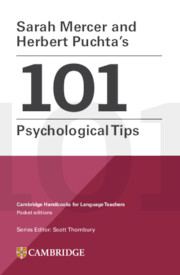Book contents
- Frontmatter
- Contents
- Acknowledgements
- Why We Wrote This Book
- A Psychological Tips for Teacher Wellbeing
- B Psychological Tips for Leading With Compassion, Authority and Skill
- C Psychological Tips for the Socio-Emotional Climate of the Group
- D Psychological Tips for Learner Engagement
- E Psychological Tips for Learner Self-Esteem
- F Psychological tips for Empowering Learners
- Index
B - Psychological Tips for Leading With Compassion, Authority and Skill
Published online by Cambridge University Press: 12 October 2023
- Frontmatter
- Contents
- Acknowledgements
- Why We Wrote This Book
- A Psychological Tips for Teacher Wellbeing
- B Psychological Tips for Leading With Compassion, Authority and Skill
- C Psychological Tips for the Socio-Emotional Climate of the Group
- D Psychological Tips for Learner Engagement
- E Psychological Tips for Learner Self-Esteem
- F Psychological tips for Empowering Learners
- Index
Summary
Teachers are typically the classroom leaders – they manage the relationships, group norms, discipline and routines, guiding everyone towards their learning goals. There are many ways teachers can lead a group, but the most effective approach is when they have strong classroom management skills combined with compassionate interpersonal skills to manage group relationships and work together with learners.
22 Start lessons quickly and firmly
23 Have an emotional check-in system
24 Use language to facilitate learner cooperation
25 Use positive micromessages with learners
26 Task students with teaching their peers
27 Use silence as a resource
28 Distribute your attention deliberately in class
29 Use measurable parameters in task instructions
30 Embrace the unexpected
31 Empower with learning contracts
32 Provide strategies to deal with exam stress
33 Develop an authoritative leadership style
34 Be authentic in your communication
35 Have clear and transparent learning objectives
36 Encourage learners respectfully to share their identities
37 Mix up work partners sometimes
38 Introduce autonomous learning in small steps
39 Focus on actions of difficult learners, not the person
40 Use celebrations wisely
41 Plan homework tasks with care
42 End the lesson deliberately and positively
22 Start lessons quickly and firmly
Get learners immediately engaged and thereby maximise learning time and reduce the risk of disruption.
The start of a lesson is a key transition in which teachers must gain learners’ attention and get them engaged and on task. Research suggests that learners can spend up to six minutes in the initial time in class on non-learning activities, which can build up to five weeks of lost instructional time over the course of a year across all subjects (Saloviita, 2013). There is a clear link between engaged learning time and learning outcomes, so such a cumulative loss of effective learning time is important to address. The start of the lesson is also the time where learners are at greater risk of becoming distracted and engaging in disruptive behaviours.
Many teachers use the initial time to carry out tasks such as taking attendance or collecting homework. Here it can be helpful to set up routines so that these things happen quickly with minimal disruption. For example, teachers can place a tray on the corner of the desk so that students always place their work there as soon as they come in.
- Type
- Chapter
- Information
- Sarah Mercer and Herbert Puchta's 101 Psychological Tips , pp. 23 - 44Publisher: Cambridge University PressPrint publication year: 2023



